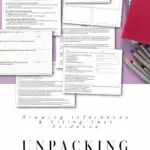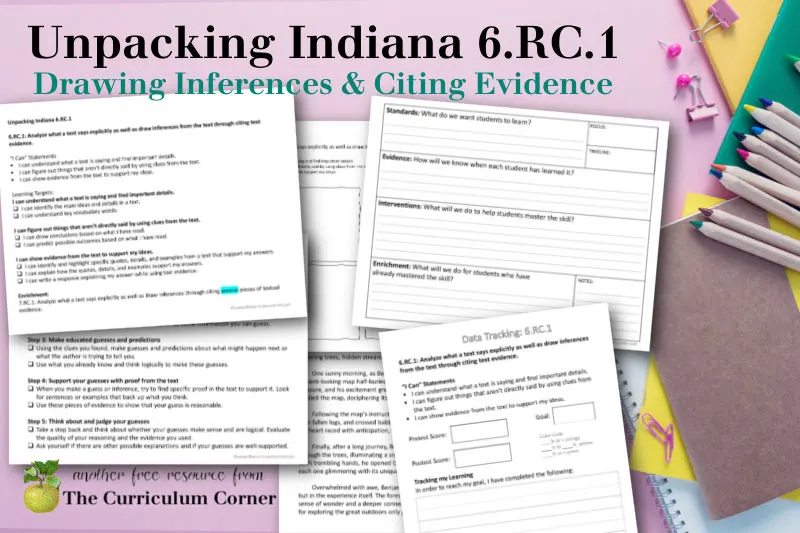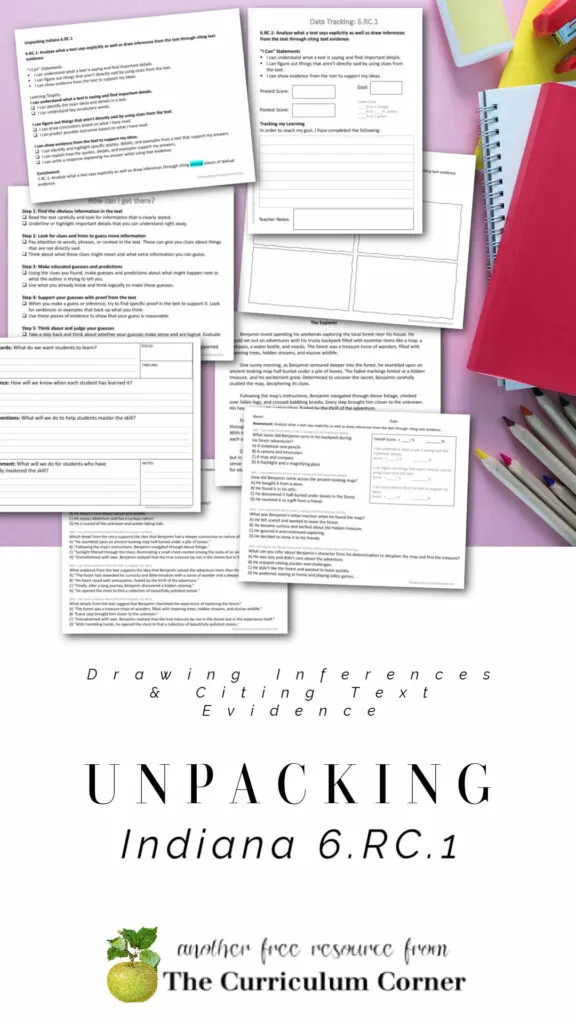Unpacking Indiana 6.RC.1: Analyze what a text says explicitly as well as draw inferences from the text through citing text evidence.
“I Can” Standards:
- I can understand what a text is saying and find important details.
- I can figure out things that aren’t directly said by using clues from the text.
- I can show evidence from the text to support my ideas.
A 6th grader who has mastered this summary will be able to:
- read a text
- understand the main ideas and details
- draw logical inferences
- provide supporting evidence from the text supporting their interpretations
- critically analyze a text
- form well-supported conclusions using text evidence
What is my goal?
After a great PLC conference, I am looking at ways to make some tasks easier for my 6th grade team next year. I am not sure how this will work, so I am starting with just one standard. If you have had success with a similar task, please feel free to share!
I am beginning by looking at one of the 6th grade essential standards in language arts. The biggest struggle I am currently facing is the size of this standard. There is just so much to this one standard!
I started by creating I Can statements to fit. This is what I came up with:
- I can understand what a text is saying and find important details.
- I can figure out things that aren’t directly said by using clues from the text.
- I can show evidence from the text to support my ideas.
Next, I worked to break the standard down into specific learning targets. These are the smaller steps students will work on in order to achieve mastery.
A 6th grader who has mastered this standard will be able to:
- identify main ideas and details in a text
- understand key vocabulary words
- draw conclusions based on what they have read
- predict possible outcomes based on the reading
- identify parts in the text to support answers
- explain the text evidence
- explain a response using text evidence
Finally, I included the seventh grade standard for students who have mastered the sixth grade standard and will be working on the next level. For this standard, the difference is that students are required to provide several pieces of text evidence.
This resource is designed to be used as a starting point. The hard work of determining how we will teach, create interventions, and create enrichment activities will be done as a team.
This still feels like a lot!
I have broken the standard down now. I feel like it is easier to understand each part of the standard. However, it still feels like so much to accomplish for just one standard.
I created a data tracking form for students to add to their data notebooks or binders. There are two options. One is single sided and the next is designed to be copied front to back. Students will record their scores and then color the box according to the color code box. They will also fill in the color code section with the percentages so they understand where their scores fall.
Their job is to then keep track of the ways they are working to master the standard.
I am sure that once my team is using this form, we will find adjustments that are needed. If you have ideas to make this form more meaningful, please share in the comments.
I did create a page for students titled “How can I get there?” I am not yet sure if I will be using this. It helped me as I was creating this resource. However, it feels like a lot of text. I might break it down more or pull out parts.
I also created a page for my team to use when starting this standard – I left it blank so that you can use this with any standard. There are two versions – one with lines and one without.
Again, I might make adjustments once we begin using this form.
Common Assessments
I took the information and used it to write three common assessments that can be used by my grade level. I’m viewing these as a starting point – I think that once we meet as a team, I will need to make some adjustments.
There are three so that one can be used as a pretest and one as a posttest. The third can then be used as a checkpoint or as an additional assessment for students who need additional instruction.
The story is on a single page. Last year I worked a lot with my students on drawing pictures in the margins and circling new words as we read. I feel like this is one strategy that was successful with most of my students. I think that after the pretest, this is one strategy we will use right away in my classroom. We will practice with this strategy. Then, I hope that students will use this as they read the passage to help them.
I like my students to have the printed story in front of them because I have found that many of my children have benefitted from the work we do on the page. However, you can also upload the story to canvas and supply them with a digital copy of the story.
An answer key is included for the three assessments.
You can download this free resource by clicking on the green apples below:
As with all of our resources, The Curriculum Corner creates these for free classroom use. Our products may not be sold. You may print and copy for your personal classroom use. These are also great for home school families!
You may not modify and resell in any form. Please let us know if you have any questions.




